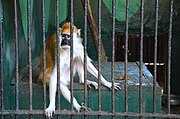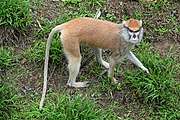Erythrocebus
| Erythrocebus | |
|---|---|

| |
| E. patas | |
| Scientific classification | |
| Domain: | Eukaryota |
| Kingdom: | Animalia |
| Phylum: | Chordata |
| Class: | Mammalia |
| Order: | Primates |
| Suborder: | Haplorhini |
| Infraorder: | Simiiformes |
| Family: | Cercopithecidae |
| Subfamily: | Cercopithecinae |
| Tribe: | Cercopithecini |
| Genus: | Erythrocebus Trouessart, 1897 |
| Type species | |
| Simia patas [1] Schreber, 1775
| |
| Species | |
Erythrocebus is a genus of Old World monkey. All three species in this genus are found in Africa, and are known as patas monkeys.[2][3] While previously considered a monotypic genus containing just E. patas, a 2017 review argued that, based on morphological evidence and heavy geographic separation between taxa, E. patas should be split back into distinct species as recognised in the 19th century.[4]
There are three species recognized.[4][5][6]
| Common name | Scientific name and subspecies | Range | Size and ecology | IUCN status and estimated population |
|---|---|---|---|---|
| Blue Nile patas monkey | E. poliophaeus (Reichenbach, 1862) |
Eastern Africa | Size: 49–64 cm (19–25 in) long, plus 43–73 cm (17–29 in) tail[7] Habitat: Forest, savanna, and shrubland[8] Diet: Gum and arthropods, as well as flowers, fruit, seeds, leaves, stems, roots, and small vertebrates[7] |
DD
|
| Common patas monkey | E. patas (Schreber, 1775) Three subspecies
|
Equatorial Africa
|
Size: 50–70 cm (20–28 in) long, plus 50–70 cm (20–28 in) tail[9] Habitat: Forest, savanna, shrubland, and grassland[10] Diet: Fruit and insects, as well as leaves, roots, and bird eggs[9] |
NT
|
| Southern patas monkey
|
E. baumstarki Matschie, 1905 |
Eastern Africa | Size: 49–64 cm (19–25 in) long, plus 43–73 cm (17–29 in) tail[7] Habitat: Forest, savanna, shrubland, and grassland[11] Diet: Gum and arthropods, as well as flowers, fruit, seeds, leaves, stems, roots, and small vertebrates[7] |
CR
|
Text is available under the CC BY-SA 4.0 license; additional terms may apply.
Images, videos and audio are available under their respective licenses.






